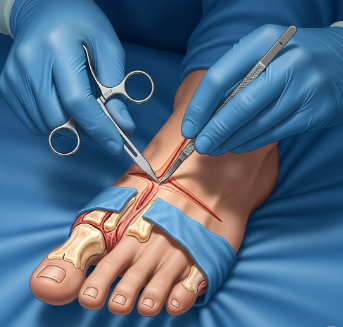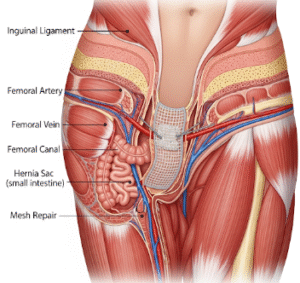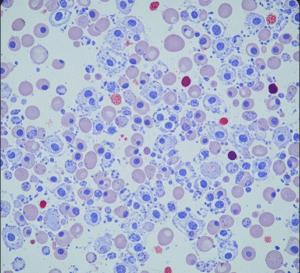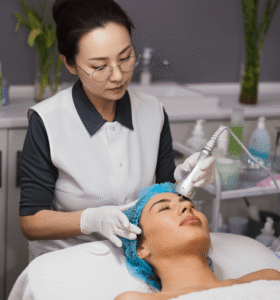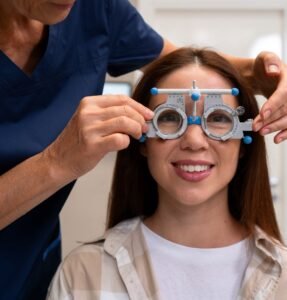Overview
Toe and forefoot amputation is a surgical procedure involving the removal of one or more toes or the front portion of the foot. It is typically performed to treat severe infections, gangrene, trauma, diabetic complications, or tumors.
In Korea, this procedure is performed in specialized orthopedic and vascular surgery centers using advanced surgical techniques, including limb-sparing and reconstructive approaches, ensuring optimal outcomes, minimal complications, and improved post-surgery mobility.
What is Toe and Forefoot Amputation?
Toe and forefoot amputation involves removing necrotic or diseased tissue from the foot, ranging from partial toe removal to removal of multiple toes and forefoot structures.
Key indications include:
- ✦ Severe infection or gangrene not responding to medical treatment.
- ➤ Complications of diabetes such as non-healing ulcers or tissue necrosis.
- ✦ Traumatic injury resulting in irreparable tissue damage.
- ➤ Tumors affecting toes or forefoot structures.
The procedure is designed to control infection, relieve pain, preserve as much function as possible, and improve quality of life.
What are the Benefits?
Toe and forefoot amputation provides several advantages:
✅ Removes infected or necrotic tissue to prevent spread.
➤ Alleviates pain and discomfort associated with severe infection or ischemia.
✦ Prevents systemic infection such as sepsis in high-risk patients.
➤ Preserves as much foot function as possible through partial amputation or reconstructive techniques.
✅ Facilitates wound healing and rehabilitation.
✦ Improves quality of life and mobility with proper post-operative care.
Procedure Details
1) How should I prepare for Toe and Forefoot Amputation?
Preparation includes:
- ✦ Medical evaluation: review medical history, vascular health, diabetes control, medications, and allergies.
- ➤ Imaging: X-ray, MRI, or CT to assess bone and soft tissue involvement.
- ✦ Laboratory tests: blood count, coagulation profile, kidney function, and blood sugar levels.
- ➤ Medication review: manage anticoagulants, insulin, or other chronic medications.
- ✦ Consent and counseling: discuss procedure type, anesthesia, risks, benefits, and post-surgical rehabilitation.
- ➤ Fasting instructions: usually 6–8 hours prior to surgery.
2) What happens during the procedure Toe and Forefoot Amputation?
The procedure is typically performed under regional or general anesthesia:
➤ Step 1: Surgical area is cleaned, sterilized, and marked for the planned amputation.
✦ Step 2: Incision made through skin and soft tissue to access affected bones and structures.
➤ Step 3: Necrotic or diseased tissue and bones are carefully removed.
✦ Step 4: Blood vessels are ligated and nerves managed to minimize pain.
➤ Step 5: Residual tissue is shaped for optimal wound healing and, if possible, prosthetic fitting.
✦ Step 6: Incision closed with sutures; sterile dressing applied, and drainage may be used if necessary.
Korean centers focus on limb-sparing techniques, infection control, and preserving maximum foot functionality.
3) What happens after Toe and Forefoot Amputation?
Postoperative care includes:
- ✦ Monitoring: vital signs, wound healing, and signs of infection.
- ➤ Pain management: oral or intravenous analgesics.
- ✦ Wound care: regular dressing changes, monitoring for infection, and maintaining clean surgical site.
- ➤ Blood sugar and vascular management: particularly important for diabetic or peripheral artery disease patients.
- ✦ Rehabilitation: physiotherapy, mobility training, and, if needed, prosthetic fitting.
- ➤ Follow-up: regular check-ups for wound healing, infection monitoring, and functional assessment.
Recovery can take several weeks to months, depending on the extent of amputation and underlying health conditions.
Risks / Benefits
Potential Risks:
- ✦ Infection at the surgical site.
- ➤ Bleeding or hematoma formation.
- ✦ Delayed wound healing, particularly in diabetic or vascular-compromised patients.
- ➤ Phantom limb pain or altered sensation in the remaining foot.
- ✦ Rare complications: deep vein thrombosis, systemic infection, or additional tissue loss.
Benefits:
- ✅ Removal of infected, necrotic, or cancerous tissue.
- ✅ Relief from pain and prevention of systemic infection.
- ✅ Preservation of as much foot function as possible.
- ✅ Facilitates rehabilitation, prosthetic fitting, and improved mobility.
- ✅ Enhanced quality of life and prevention of further complications.
Recovery and Outlook
Recovery after toe and forefoot amputation generally includes:
- ➤ Immediate care: pain management, wound monitoring, and infection prevention.
- ✦ Activity: gradual mobility with walking aids, avoiding weight-bearing on the surgical site initially.
- ➤ Physiotherapy: improve balance, gait, and strength.
- ✦ Prosthetic fitting: for partial forefoot amputations, to restore functional mobility.
- ➤ Follow-up: regular assessment of wound healing, foot function, and management of underlying conditions (e.g., diabetes).
- ➤ Long-term outcome: most patients achieve infection control, pain relief, and functional mobility with proper rehabilitation and care.
When To Call the Doctor
Contact your healthcare provider if you notice:
⚠ Increasing redness, swelling, or pus at the surgical site.
⚠ Fever or signs of systemic infection.
⚠ Uncontrolled pain or new numbness.
⚠ Poor wound healing or unexpected bleeding.
⚠ Difficulty walking or balance problems post-surgery.
Best Korea Option / Process
Korea provides world-class toe and forefoot amputation with:
- ✦ Experienced orthopedic and vascular surgeons skilled in limb-sparing and reconstructive techniques.
- ➤ Advanced infection control and surgical equipment for safe and precise surgery.
- ✦ Focus on preserving foot function and enabling prosthetic fitting when necessary.
- ➤ Comprehensive pre- and post-operative care, including rehabilitation, wound care, and physiotherapy.
- ✦ Safe and effective procedures for both domestic and international patients.
- ➤ Multidisciplinary care ensures optimal functional recovery, pain control, and improved quality of life.
Korean centers ensure patients receive precise, safe, and effective amputation procedures with minimal complications and optimal functional outcomes.
Highlights of Toe and Forefoot Amputation in Korea
- ✅ Removes infected, necrotic, or cancerous tissue safely.
- ➤ Preserves as much foot function as possible.
- ✦ Minimally invasive and reconstructive techniques available.
- ➤ Comprehensive rehabilitation and physiotherapy support.
- ✅ Expert pre- and post-operative care in advanced Korean centers.

